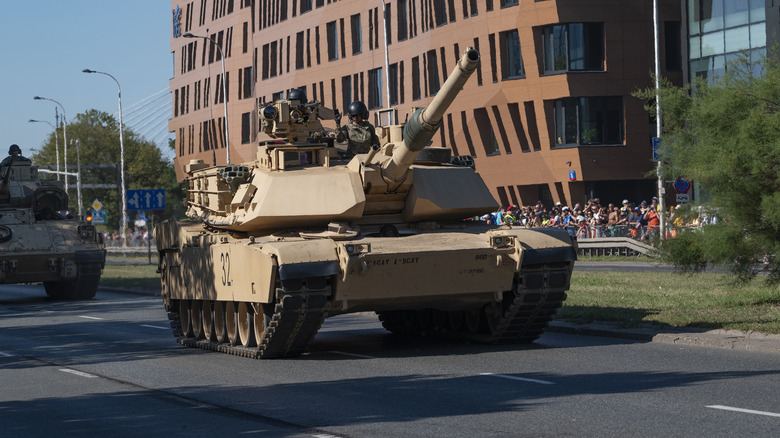The Next Abrams Tank Goes Hybrid, And It's Deploying Soon
Tanks, like full-grade military tanks, are probably the last vehicle you'd think about when talking about hybrid, fuel-efficient options. They're lean, mean, green machines meant to traverse the toughest terrain imaginable in war-torn regions while hauling some of the most advanced fighting capabilities and equipment known to man. But the Army's next-generation M1E3 Abrams tank will feature a hybrid powertrain that's fuel efficient and quieter than traditional powertrains, potentially adding a small layer of stealth. General Dynamics hopes to have a prototype fielded by the end of 2026.
Speaking at a panel, Danny Deep, executive vice president for Global Operations at General Dynamics, the company designing the new M1E3 prototype, explained that field testing would give them valuable information (via Defense News). GD wants soldiers to get their hands on it and to give notes on what works and what doesn't work. "Then in short order after that, we're going to start delivering this capability in the next two to three years, as opposed to the next 10."
There could be a hybrid Abrams tank dominating the field within the next four or five years, maximum, which would be impressive. Overall, the new model would be lighter with an "improved powertrain," while retaining the powerful M1 Abrams original and iconic characteristics, like the 120 mm smoothbore main gun. General Dynamics is also responsible for developing one of the world's most advanced nuclear-powered submarines for the U.S. Navy, so it's no stranger to unique and innovative designs.
What's with the redesign and why so fast?
The military plans to scrap some of the Abrams' traditional design and increase its mobility and survivability on the battlefield via modernization. The hybrid powertrain is part of that mission. James McConville, the 40th Chief of Staff of the Army from 2019 to 2023, explained there's a need to futureproof military solutions. According to DefenseNews, McConville said, "The notion of speed, range and convergence, the ability to locate targets on the battlefield and quickly service them with lethal means is going to be very, very important now and even more important in the future."
Of course, field testing will be the real proof that it offers the promised capabilities. There's no mention of the batteries or electronics that will power the unique drivetrain, but since high-density batteries are going to power next-gen soldiers, it's safe to assume the tank's will be fairly advanced, as well. As for how the design is coming about so fast, and why it's almost ready, Danny Deep thanks a combination of factors, including the tech's modularity, open architecture, and smart, digital engineering.
The new tank design can incorporate components already available commercially. "Everybody believes speed wins, not just on the battlefield, but in terms of how you get capability out to the soldier." When mass producing the new equipment, borrowing parts from diesel Caterpillar engines, for example, is how the Army can adopt existing parts and speed up development. Modernization is also why the U.S. Navy is working on a new nuclear supercarrier, keeping the U.S. military on the cutting-edge of naval warfare.

